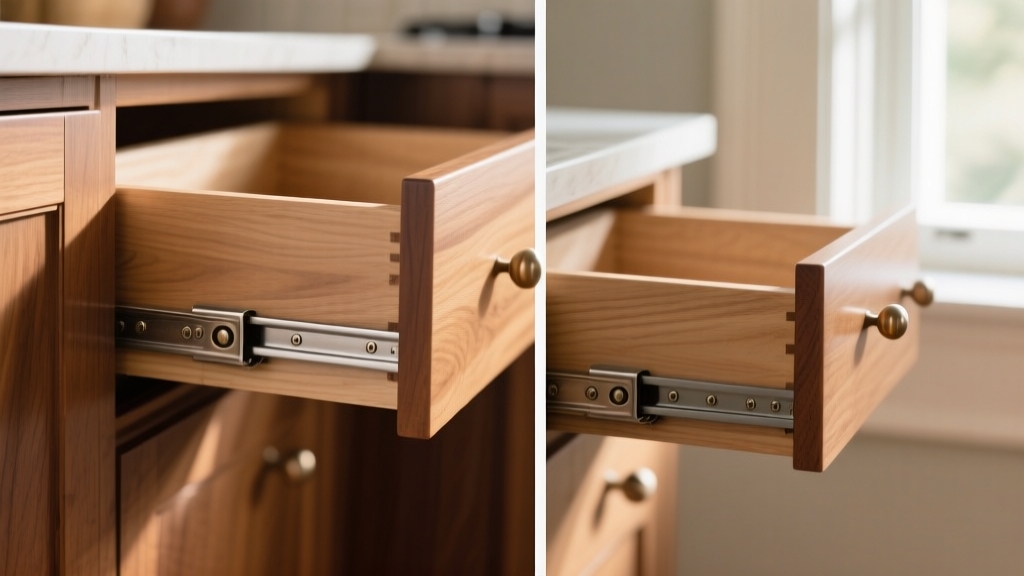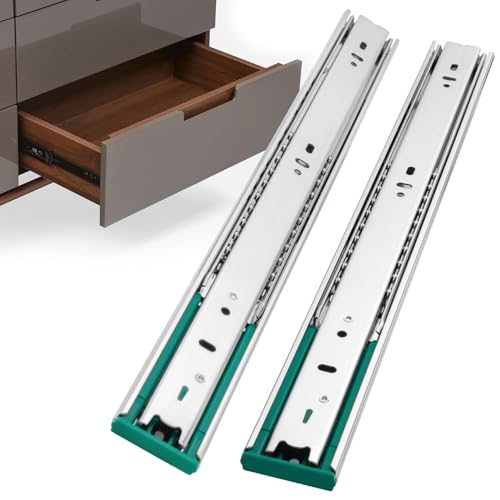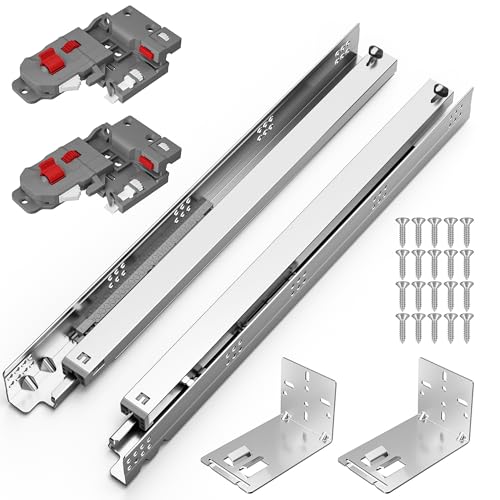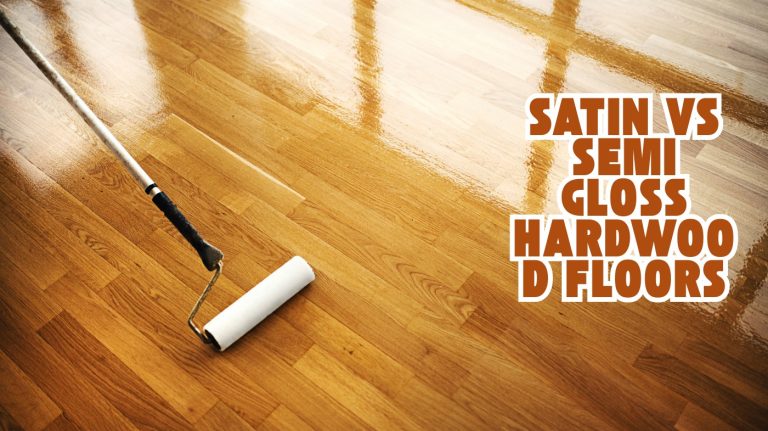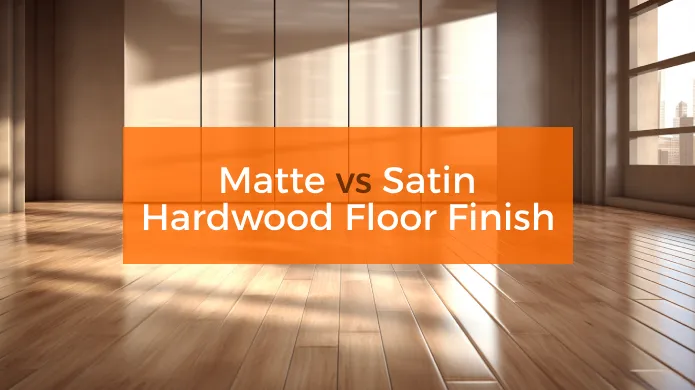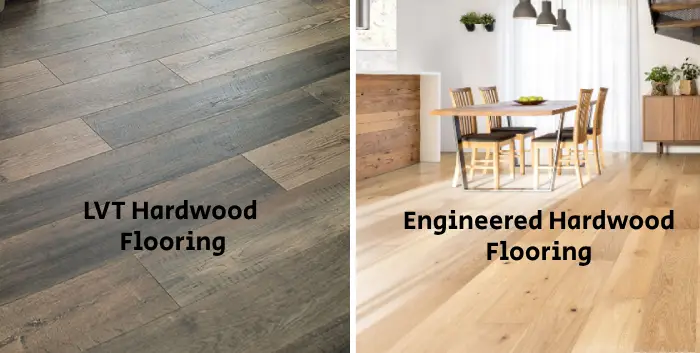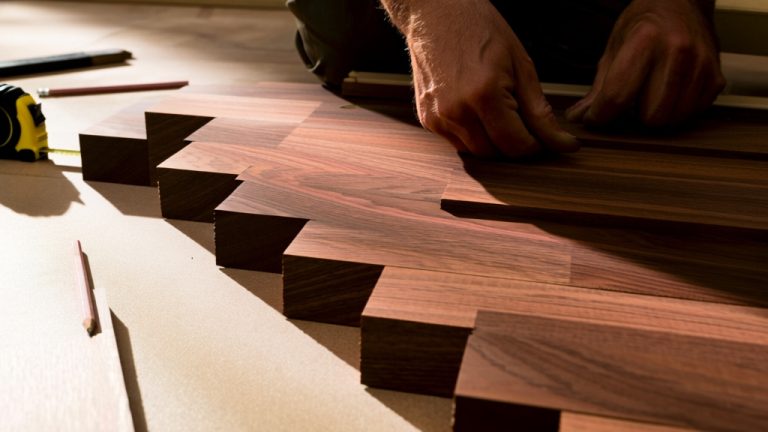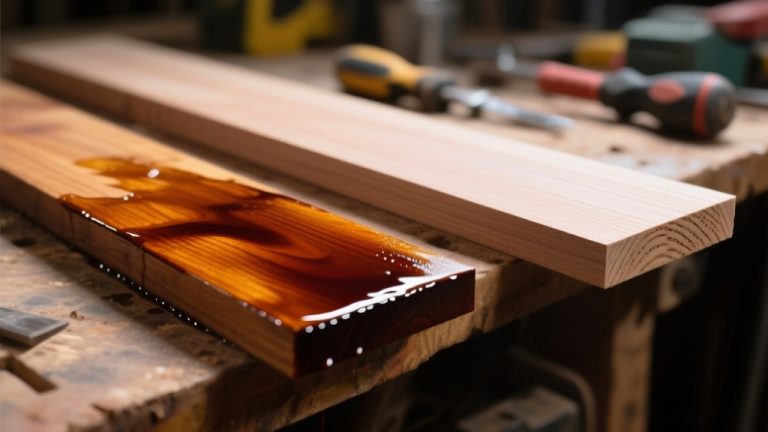Side Mount vs Undermount Drawer Slides: Comparison Guide
You’ll find side mount drawer slides easier to install and better for heavy loads, supporting up to 1,300 pounds with exposed hardware. Undermount slides offer a sleek, concealed look, maximizing drawer width and delivering smooth, quiet motion for moderate weights.
They require precise installation but enhance aesthetics with full extension and soft-close options. Choosing the right slide depends on your project’s load demands and style preferences.
Keep exploring for a detailed comparison to guide your decision.
- 【Installation Note】 Color: Black; Qty: 1 pair. Length: 12″(304.8mm), full extension lengths:…
- 【Full Extension & Ball Bearing Design 】— 3-setions fold is convenient to fully open the drawer…
- 【Detachable 】 The back of the slide rail is designed with a detachable buckle, which is more…
- SOFT CLOSE AND FULL EXTENSION: Full extension opening allows for the entire drawer to be…
- DURABLE AND COMPATIBLE: Made from high-grade Galvanized steel, Intended for use with Face Frame or…
- INSTALLATION PRECAUTIONS:The overall length is 21.4 inches (543mm). They are suitable for drawers…
Key Takeaways
- Side mount slides are easier to install and more budget-friendly, suitable for heavier loads and traditional drawer designs.
- Undermount slides offer a sleek, concealed look, maximizing drawer width and supporting modern cabinetry aesthetics.
- Side mount slides support heavier weights (up to nearly 1,300 lbs) and are more forgiving with installation tolerances.
- Undermount slides provide smoother operation, full extension, and minimal lateral play but require precise installation.
- Both slide types can include soft-close features, but undermounts generally cost more due to complexity and concealed hardware.
Side Mount or Undermount Drawer Slides: Key Differences
| Feature | Side Mount Drawer Slides | Undermount Drawer Slides |
|---|---|---|
| Installation Difficulty | Easier to install with basic tools; forgiving of minor misalignments | Requires precise measurements and advanced carpentry skills |
| Weight Capacity | 75–1,300 pounds; ideal for heavy-duty applications | 75–150 pounds; best for light to medium loads |
| Price Range | $5–$15 per pair; budget-friendly option | $14–$50 per pair; premium pricing for advanced features |
| Hardware Visibility | Exposed metal hardware on drawer sides | Fully concealed beneath drawer box for sleek appearance |
| Drawer Width Impact | Reduces usable drawer width by approximately 1 inch | Maximizes internal width for increased storage capacity |
| Extension Capability | Limited full extension; some lateral movement | Full extension with smooth, linear movement |
| Noise Level | May produce more noise during operation | Quieter operation (≤28dB with soft-close); minimal sound |
| Aesthetic Appeal | Traditional, utilitarian look; visible hardware | Modern, minimalist design; invisible installation |
| Adjustment Ease | Easier to adjust after installation | Requires precise alignment; less forgiving of errors |
| Best For | Heavy loads, budget projects, traditional cabinetry | High-end kitchens, modern designs, optimized storage |
Installation Complexity Comparison
While side mount slides are generally easier to install and accommodate most standard drawer boxes without modification, undermount slides demand more precise measurements and specialized drawer construction.
This includes clearances and notches, making their installation more complex and less forgiving of errors. Proper alignment is crucial to avoid binding issues that can impair drawer function.
When installing side mounts, you align both slide members level with a 1/16″ setback from the cabinet face, accounting for the typical 1/2 inch thickness on each side. Minor misalignments can cause binding but are easier to adjust. Side-mount slides are also more visible hardware, which can influence aesthetic choices.
In contrast, undermount slides require careful clearance underneath the drawer, rear notches, and precise height and tilt adjustments. Even small errors risk binding or premature wear. You’ll need to follow manufacturer’s instructions closely and measure with high accuracy to ensure smooth operation and longevity.
Cost Differences Between Side Mount and Undermount Slides
Because undermount slides incorporate more complex design features and concealed hardware, they generally come with a higher price tag than side-mount slides. These slides also often require precise installation to ensure smooth operation and avoid damage.
Undermount options typically start around $14 to $28 per pair, with premium brands like Blum and Salice reaching $20 to $50 due to advanced features such as soft-close and 3-way adjustment. For example, Blum Tandem slides feature Blumotion soft-close for silent, gentle closing and easy adjustment, adding to their premium cost.
In contrast, side-mount slides often cost about half as much, with common brands priced between $10 and $15 per slide, and bulk purchases lowering costs further. The price difference reflects design complexity, material quality, and added functionality in undermount slides.
While side-mount slides are more budget-friendly and reduce installation costs, undermount slides’ higher initial investment often includes enhanced durability & aesthetic appeal.
Weight Capacity and Load Support Analysis
Beyond cost considerations, understanding the weight capacity and load support differences between side mount and undermount drawer slides is key to selecting the right hardware for your project.
Side mount slides typically support weights from 75 to over 500 pounds, using dual parallel ball-bearing mechanisms that evenly distribute load and handle lateral compression efficiently. They are known for their higher weight capacity, making them suitable for heavy loads and demanding environments.
Heavy-duty models can sustain up to nearly 1,300 pounds, making them ideal for robust, wide, or heavy drawers. Conversely, undermount slides generally support 75 to 150 pounds, bearing weight vertically but offering weaker lateral support due to their thinner, bottom-mounted design.
They excel in light to medium-duty applications but risk binding or damage if overloaded or misaligned. For heavy or dynamic loads, side mounts ensure superior durability and smoother operation, whereas undermounts require careful selection and installation to avoid premature failure.
Aesthetic Appeal and Design Integration
How does hardware visibility influence your drawer’s overall aesthetic? Undermount slides remain fully concealed beneath the drawer box, providing an invisible installation that supports minimalist, contemporary designs by eliminating visual clutter.
Hardware visibility defines style; undermount slides offer a sleek, clutter-free look perfect for modern spaces.
This hidden hardware enables seamless integration and maintains uninterrupted sightlines, ideal for modern kitchens and offices prioritizing sleek profiles. Conversely, side mount slides attach visibly to drawer sides, exposing metal hardware that contributes a functional, utilitarian element.
This visibility aligns with traditional and classic cabinetry, where mechanical components are accepted or embraced as design features, preserving historical authenticity.
Choosing undermount slides achieves a clean, hardware-free appearance consistent with minimalist philosophies, while side mount slides offer transparent functionality compatible with conventional aesthetics.
Your choice fundamentally shapes how your furniture communicates style and design intent. Consider environmental factors such as moisture control to maintain the integrity and longevity of your drawer slides and cabinetry.
Space Efficiency and Storage Optimization
When optimizing drawer space, the choice between side mount and undermount slides critically impacts both storage capacity and usability.
Undermount slides maximize internal drawer width by mounting beneath the drawer, enhancing storage volume and allowing full extension for better access. Their hidden design also contributes to a seamless and minimalist aesthetic that complements high-end furniture styles.
Additionally, their installation requires precise surface preparation for optimal performance. Side mount slides, attached to the drawer sides, reduce the usable width and demand thicker drawer sides, limiting space efficiency especially in narrow drawers.
| Feature | Side Mount Slides | Undermount Slides |
|---|---|---|
| Internal Width Impact | Reduces usable drawer width | Maximizes drawer width |
| Drawer Thickness Requirement | Requires thicker sides | Compatible with thinner drawers |
| Storage Access | Limited full extension | Full extension capability |
| Cabinet Compatibility | More versatile | Requires precise construction |
Operational Performance and Drawer Movement
Selecting the right drawer slide affects not only storage capacity but also how smoothly and reliably your drawer operates.
Undermount slides provide fluid, consistent linear movement with minimal lateral play due to their bottom-center rail placement. This enables full extension and reduces jamming risks. Their concealed design fosters quieter, smoother operation, supported by engineered mechanisms that evenly distribute weight.
Additionally, undermounts often feature soft-close mechanisms that enhance user experience by preventing slamming. However, installation precision is more critical with undermounts; any misalignment notably impacts function, making it essential to maintain proper alignment during setup.
Undermount slides ensure smooth, quiet operation with full extension and minimal lateral play through bottom-center rail design.
Side-mount slides, however, can exhibit lateral movement and occasional binding if misaligned. Their side placement restricts extension and exposes hardware to wear.
While side mounts support higher weight loads, their operation may be less smooth and noisier. Side mounts are generally easier to install and adjust, contributing to more reliable operational performance in variable conditions.
Soft-Close Features and Enhancements
Although traditional drawer slides provide basic functionality, soft-close mechanisms considerably enhance user experience by ensuring smooth, silent, and controlled drawer closure.
These systems utilize a hydraulic damping mechanism, triggered in the last 3cm of travel, to deliver a feather-like closing effect while markedly reducing noise levels to ≤28dB. This protects both the drawer and cabinet from impact damage.
When you choose soft-close slides, consider these enhancements:
- Durability: Rated for over 80,000 cycles, they withstand temperatures from -20℃ to 120℃ and support loads up to 45kg. Many manufacturers also offer customized services to tailor coating thickness, damping, and specifications to specific project needs.
- Safety: Controlled closure prevents finger injuries and damage to drawer contents. It is important to keep components clean and well-maintained to avoid issues similar to those caused by debris buildup that can impair mechanical parts.
- Installation: Side mount versions are easier to install, while undermount require precise calibration for peak performance. Proper maintenance, such as cleaning and checking for jammed or broken parts, ensures smooth operation and protects surfaces from damage.
Selecting the Right Slide for Your Project Needs
When you’re deciding between side-mount and undermount slides, it’s essential to think about your installation skills first. Side-mount slides are generally easier to install, which is great if you’re not super experienced.
On the other hand, undermount slides require a bit more precision, so keep that in mind if you’re tackling this project yourself. Next up, let’s talk budget. If you’re looking for something more cost-effective, side-mount options are typically the way to go. They won’t break the bank like some of the pricier undermount slides can.
Lastly, you’ll want to evaluate your design and functionality needs. Consider things like visibility, load capacity, and how you can optimize space for your project.
Balancing all these factors will help you make the best choice for your needs. Also, keep in mind that proper installation and material selection are crucial for extending the lifespan and ensuring optimal performance of your drawer slides, similar to considerations in material durability for flooring.
Installation and Skill
Because undermount drawer slides demand precise alignment and specialized tools, they often require more advanced carpentry skills and patience to install correctly. You’ll need drills, levels, and possibly jigs to guarantee smooth operation, as misalignment can cause binding or scraping.
Furthermore, undermount slides feature rollers or small rail systems that contribute to their smooth and quiet operation, which requires careful installation to function properly. Ensuring proper ventilation during installation can help reduce exposure to any volatile organic compounds released from wood adhesives.
In contrast, side mount slides are easier to install with basic tools like screwdrivers and tape measures. Consider these points when choosing your slide type:
- Skill Level: Undermount slides suit experienced DIYers or professionals; side mounts fit beginners.
- Tools Required: Undermount installation needs precise measuring tools and alignment guides; side mounts require minimal equipment.
- Installation Time: Undermount slides take longer due to multiple alignment checks; side mounts install quickly and efficiently.
Choose based on your comfort with these demands to assure proper function and durability.
Cost and Budget
Selecting the right drawer slide hinges considerably on your budget constraints and project requirements.
Side-mount slides usually cost less; basic models start around $5 per pair, making them ideal if you need many slides or have tight budgets. Their simpler design reduces manufacturing and installation costs.
For kitchen cabinets, the Knape & Vogt KV8400 Series is a reliable and cost-effective option known for its smooth, full extension action. Additionally, side-mount slides are more susceptible to wear if exposed to excessive moisture, so environmental factors should be considered when choosing.
Undermount slides often range from $17 to $50 and include advanced features like soft-close dampers and concealed hardware, increasing costs. These slides support heavier loads and offer enhanced durability, which may justify their price in heavy-use or aesthetic-focused projects.
Their installation requires precise spacing and acclimation to avoid issues such as buckling or misalignment caused by improper fitting.
Consider load capacity, slide length, and special mechanisms, as these factors affect pricing in both types. Prioritize side-mounts to optimize costs for standard applications, but allocate more budget for undermounts when durability and quiet operation are essential.
Design and Functionality
Although both side-mount and undermount drawer slides serve the fundamental purpose of enabling drawer movement, they differ considerably in design and functionality. This directly impacts your project’s aesthetics, load capacity, and installation complexity.
To select the right slide for your needs, consider these factors:
- Aesthetics: Undermount slides hide hardware, offering a sleek, modern look. Side-mount slides remain visible, suiting traditional or utilitarian designs.
- Load Capacity: Side-mount slides support heavier loads, making them ideal for heavy-duty storage. Undermount slides handle moderate weights with smoother operation.
- Installation: Side-mount slides are easier to install with forgiving tolerances. Undermount slides require precision but provide features like soft-close and full extension.
Choose based on whether you prioritize style, strength, or installation ease for your cabinetry project. Proper care and maintenance, similar to routine maintenance of hardwood floors, can greatly extend the lifespan and performance of your drawer slides.
Frequently Asked Questions
Can Side Mount Slides Be Retrofitted to Existing Cabinets Easily?
You can retrofit side mount slides to existing cabinets, but it’s not always straightforward. You’ll need to remove old slides completely, modify drawer boxes to provide about 1/2″ side clearance, and possibly use shims for proper spacing.
Face frame cabinets or narrow openings may require additional adjustments like bracket mounting or stile removal. With precise measuring, drilling guides, and careful planning, you can upgrade without rebuilding drawers fully.
Are There Specific Brands Known for Durable Undermount Slides?
If you want slides that’ll outlast a century, brands like Blum, Knape & Vogt, and Hettich stand out for durable undermount drawer slides. They offer up to 125 lbs load capacity, smooth full extension, and soft-close features.
Salice and Accuride also provide robust options with rust-resistant zinc plating. For heavy-duty needs, Fulterer excels with up to 450 lbs capacity. Choose based on load, smoothness, and installation ease.
How Do Temperature Changes Affect Drawer Slide Performance?
Temperature changes affect your drawer slides by causing thermal expansion and contraction. This can lead to misalignment and increased wear.
High heat can degrade plastic and rubber parts, making slides brittle or causing them to fail over time. Lubricants may thin or harden outside ideal temperature ranges, which increases friction and noise.
To maintain performance, use heat-resistant materials and EP-rated grease. Allow proper clearance during installation to accommodate temperature-induced movement.
What Maintenance Is Required to Prolong Slide Lifespan?
To prolong slide lifespan, you should regularly clean slides by removing dust and debris monthly. Perform deeper cleanings quarterly. Lubricate them every 3–6 months using silicone-based or graphite lubricants, avoiding oils that attract dirt.
Routinely inspect slides for wear, misalignment, or loose screws, addressing any issues promptly. Tighten hardware, realign slides as needed, and replace damaged parts to maintain smooth, reliable operation and prevent premature failure.
Are There Eco-Friendly Materials Used in Drawer Slide Manufacturing?
Back in the days of steam engines, sustainability wasn’t a concern. Now you’ll find eco-friendly materials like recycled metals and aluminum composites in drawer slide manufacturing.
These materials reduce environmental impact without compromising durability. You’ll also see advanced, eco-friendly coatings that minimize chemical waste during production.
Using these innovations, manufacturers extend product lifespan and lower carbon footprints. This helps you choose slides that are both sturdy and kind to the planet.
Transform Your Cabinetry With the Perfect Drawer Slides
When choosing between side mount and undermount drawer slides, consider that undermount slides support up to 100 pounds more than side mounts. This offers superior load capacity without sacrificing smooth operation.
This difference can markedly impact your project’s durability and functionality. By understanding installation, cost, and design factors, you can select the most efficient slide that meets your specific needs.
This ensures a reliable, aesthetically pleasing drawer system that performs flawlessly every time.
- Quiet Environment for Family:Homdiy soft close drawer slides equip premium soft close…
- High Quality Material: Our full extension drawer slides mad of high grade cold-rolled steel with…
- Measurements:Length:22inch(550mm);Width:1.77inch(45mm);Thickness: 1/2inch(12.7mm); Load-bearing…
- Effortless Soft-Close & Full Drawer Access: The hydraulic damper features to slowly closed the…
- Heavy-Duty Build & Simple Installation: Undermount drawer slides are made of top-grade galvanized…
- Modern Look & Enhanced Safety: The concealed slide design not only gives your drawers a sleek,…
Last update on 2025-12-14 / Affiliate links / Images from Amazon Product Advertising API

